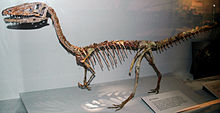| Revision as of 22:18, 29 January 2023 editOAbot (talk | contribs)Bots441,761 editsm Open access bot: hdl added to citation with #oabot.← Previous edit | Revision as of 07:27, 9 February 2023 edit undo211.212.202.168 (talk)No edit summaryTags: Mobile edit Mobile web editNext edit → | ||
| Line 12: | Line 12: | ||
| | subdivision_ranks = Subgroups | | subdivision_ranks = Subgroups | ||
| | subdivision = *{{extinct}}'']'' | | subdivision = *{{extinct}}'']'' | ||
| *{{extinct}}'']'' |
*{{extinct}}'']'' | ||
| *{{extinct}}'']'' | *{{extinct}}'']'' | ||
| *{{extinct}}'']'' | *{{extinct}}'']'' | ||
Revision as of 07:27, 9 February 2023
Extinct superfamily of dinosaurs
| Coelophysoids Temporal range: Late Triassic-Early Jurassic, 228–183 Ma PreꞒ Ꞓ O S D C P T J K Pg N | |
|---|---|

| |
| Mounted skeleton of Coelophysis bauri, Cleveland Museum of Natural History | |
| Scientific classification | |
| Domain: | Eukaryota |
| Kingdom: | Animalia |
| Phylum: | Chordata |
| Clade: | Dinosauria |
| Clade: | Saurischia |
| Clade: | Theropoda |
| Clade: | Neotheropoda |
| Superfamily: | †Coelophysoidea Nopcsa, 1928 |
| Type species | |
| †Coelurus bauri Cope, 1887 | |
| Subgroups | |
| Synonyms | |
| |
Coelophysoidea were common dinosaurs of the Late Triassic and Early Jurassic periods. They were widespread geographically, probably living on all continents. Coelophysoids were all slender, carnivorous forms with a superficial similarity to the coelurosaurs, with which they were formerly classified, and some species had delicate cranial crests. Sizes range from about 1 to 6 m in length. It is unknown what kind of external covering coelophysoids had, and various artists have portrayed them as either scaly or feathered. Some species may have lived in packs, as inferred from sites where numerous individuals have been found together.
Examples of coelophysoids include Coelophysis, Procompsognathus and Liliensternus. Most dinosaurs formerly referred to as being in the dubious taxon "Podokesauridae" are now classified as coelophysoids.
Classification
Despite their very early occurrence in the fossil record, coelophysoids have a number of derived features that separate them from primitive (basal) theropods. Among the most prominent of these derived features (apomorphies) is the way the upper jaw bones are connected (the premaxilla-maxilla articulation), which is flexible with a deep gap between the teeth in the two bones. A major source of disagreement among theropod experts is whether or not coelophysoids shared a more recent common ancestor with Ceratosauria (sensu stricto) than the ceratosaurs did with other theropods. Most recent analyses indicate the latter, that Coelophysoidea does not form a natural group with the ceratosaurians. Similarly, while Dilophosaurus and similar theropods have traditionally been classified as coelophysoids, several studies published in the late 2000s suggested that they may actually be more closely related to the tetanurans.
The cladogram below was recovered in a study by Matthew T. Carrano, John R. Hutchinson and Scott D. Sampson, 2005.
| Coelophysoidea |
| ||||||||||||||||||||||||||||||||||||
The cladogram below was recovered in a study by Martin D. Ezcurra and Gilles Cuny, 2007.
| |||||||||||||||||||||||||
The cladogram below was recovered in a study by Ezcurra et al. (2020).
| Coelophysoidea |
| ||||||||||||||||||||||||||||||||||||||||||||||||||||||
See also
References
- Smith, N.D., Makovicky, P.J., Pol, D., Hammer, W.R., and Currie, P.J. (2007). "The dinosaurs of the Early Jurassic Hanson Formation of the Central Transantarctic Mountains: Phylogenetic review and synthesis." In Cooper, A.K. and Raymond, C.R. et al. (eds.), Antarctica: A Keystone in a Changing World––Online Proceedings of the 10th ISAES, USGS Open-File Report 2007-1047, Short Research Paper 003, 5 p.; doi:10.3133/of2007-1047.srp003.
- Carrano, M.T, Hutchinson, J.R, Sampson, S.D. (2005). "New information on Segisaurus halli, a small theropod dinosaur from the Early Jurassic of Arizona." Journal of Vertebrate Paleontology. 25(4):835-849.
- Ezcurra, Martin D.; Cuny, Gilles (2007). "The coelophysoid Lophostropheus airelensis, gen. nov.: a review of the systematics of "Liliensternus" airelensis from the Triassic-Jurassic boundary outcrops of Normandy (France)". Journal of Vertebrate Paleontology. 27 (1): 73–86. doi:10.1671/0272-4634(2007)27[73:TCLAGN]2.0.CO;2.
- Ezcurra, Martín D; Butler, Richard J; Maidment, Susannah C R; Sansom, Ivan J; Meade, Luke E; Radley, Jonathan D (2021-01-01). "A revision of the early neotheropod genus Sarcosaurus from the Early Jurassic (Hettangian–Sinemurian) of central England". Zoological Journal of the Linnean Society. 191 (1): 113–149. doi:10.1093/zoolinnean/zlaa054. hdl:11336/160038. ISSN 0024-4082.
Sources
- Rauhut and Hungerbuhler (2000). "A review of European Triassic theropods." Gaia, 15: 75-88.
- Tykoski, R. S. (2005). "Anatomy, Ontogeny, and Phylogeny of Coelophysoid Theropods." Ph. D dissertation.
- Yates, A.M., 2006 (for 2005). "A new theropod dinosaur from the Early Jurassic of South Africa and its implications for the early evolution of theropods." Palaeontologia Africana, 41: 105-122.
| Taxon identifiers | |
|---|---|
| Coelophysoidea | |














